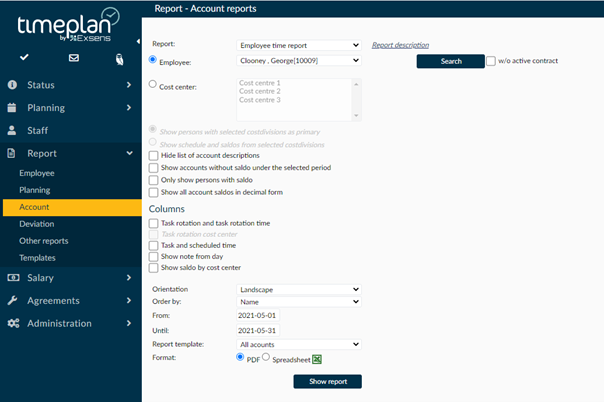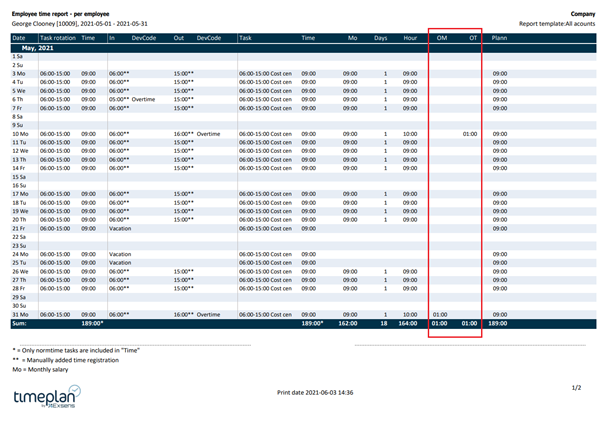Employee time report
The most frequently used report in Timeplan is Employee time report. This report provides a good overview of the schedule and events during the selected period for individual employees.
The most frequently used report in Timeplan is Employee time report. This report provides a good overview of the schedule and events during the selected period for individual employees. The report, combined with a report template that shows all accounts, is a good basis that shows which times and accounts that will be used as basis for the employee's salary.
The report is found under Reports – Account – Employee time report and contains a number of selections. The report can be generated by cost centre or per person. Even when the report is prepared by expense centre, each individual is shown consecutively and the final summary on the last page is displayed for the entire cost centre.
The report can be tailored to the user's needs using the several different selections.
Making a selection
Start by choosing whether to display the report per employee or per cost centre. When selecting a person, move the marker to Employee and select the current employee from the drop-down list. When selecting a cost centre, mark that selection, and then select one or more cost centres that you want to display.
After that, there are selection boxes to check for the ability not to display account description, to display account columns that are not used (which means that only people who have a balance on an account during the selected period are displayed), or to display the balances in decimal form. The account description appears at the end of the report and is a translation key for what each account column stands for. If you choose to mark that you want to see account balances in decimal form, each balance will be displayed in tenth parts, for example, 3 hours 30 minutes will be 3.5 hours in this form. Normally, the account balances are displayed in hours and minutes corresponding to form 3:30.
Under Optional columns, additional selections can be made. Here you can choose to see Task rotation and the timetable time, the cost centre of the timetable, which is practical when the employee is working at multiple cost centres during the selected period, current shift and the hours of the shift, View note from day and View balance per cost centre.
Seeing the task rotation timetable against the current shift can be useful when these two differ from each other. This gives you a quick overview of which shifts have been moved etc. during the selected period. If the employee works where compensatory time or overtime is calculated against their timetable (not annual working hours and hour bank, which are calculated against the weekly working hours) and has a task rotation that is consistent with the weekly working hours on the employment agreement, you are advised to view both of these choices in the report.
Then select which orientation, sorting and period to display. You also have the option to select a report template. The report template governs which accounts are to be displayed in the report and in what order. Selecting a report template that only appears as a dash means that you will not display any account balances, but only timetables, deviation codes and stamps. You can also print the report in PDF or Excel in order to process the information further.
Reading the report
The report you receive now shows the accounts that are matched to the payroll system used by the customer. Therefore, the accounts may be named a little different in the report; questions about these are answered by the customer's payroll manager.
The report now shows the dates and days of the week, the employee's stamps and deviation codes, any task rotation and their hours, current timetable and work shift, cost centre and the balances of the selected accounts.
If stamps show an asterisk/*, this means that these are not made in the stamp terminal by the employees themselves, but by the manager from within the administration interface.
Below is a report that shows a person with monthly salary who is working on an agreement where the employee's overtime and compensatory time are calculated based on the timetable.
When the employee is working against a timetable, it is extra important to ensure that the timetable corresponds to the weekly working hours. As a basis for this, the employee must have a task rotation that is consistent with the weekly working hours and that rolls over time. You can read more about this in our article at Timetable in connection with Additional Hours and Overtime. If the instructions in the article are followed, the employee's time will be correct and this can be verified when the time of the task rotation and the time of the current shifts match. If there is a difference, this may mean that there are no shifts or that there are too many shifts during the month, which means that the compensatory time will not be calculated correctly and the employee risks working less than or too much against their monthly salary that month. Compensatory time, additional time and overtime are calculated from the column for the current shift.
If you find errors in your report regarding stamps, work shifts, deviation codes or account balances, it is now easy (after the overview provided by the report) to go back to Staff – [the employee] –Time rec. and balances for the current day and correct the error before it is submitted to payroll. Generate the report again and check whether it matches against the time worked for the month.

